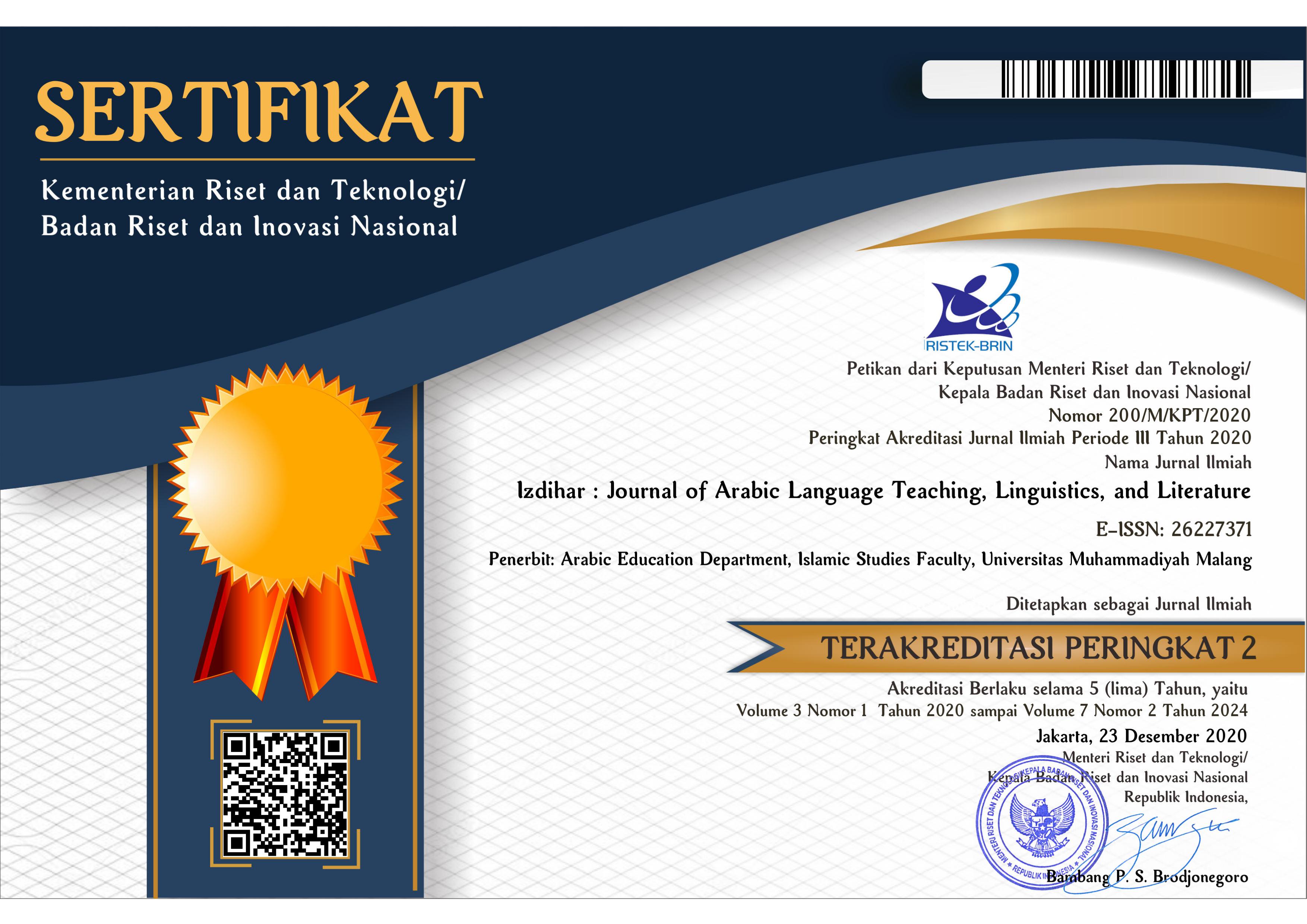The Analysis of Multiliteracy Aspects in Arabic Books for Madrasah Aliyah
DOI:
https://doi.org/10.22219/jiz.v7i1.30111Keywords:
Arabic Learning, Teaching Materials, MultiliteracyAbstract
This study aimed to analyze the Arabic book for the 10th grade of Madrasah Aliyah, published by the Ministry of Religious Affairs of the Republic of Indonesia in 2020, based on the multiliteracy concept. The primary data source in this study is a 10th-grade Arabic textbook, whereas the secondary data is literature on the subject themes. The data analysis technique employs content analysis. The results reflect the context, which frequently refers to the situational context. The At Ta'am wa Sharāb chapter explores a natural science theme. The multimedia element includes both text and visual media. As for audio for listening learning, it is not yet in all chapters. As for the multicultural aspect, most of them contained Indonesian culture. There is one theme that contained Arab culture and one that contains American culture. Based on the analysis results, Arabic books are not optimal in containing the concept of multiliteracy.
Downloads
References
Abidin, Y. (2018). Pembelajaran Multiliterasi : Sebuah Jawaban Atas Tantangan Pendidikan Abad Ke-21 dalam Konteks Keindonesiaan. Refika Aditama.
Abidin, Y., Mulyati, T., & Yunansah, H. (2021). Pembelajaran Literasi: Strategi Meningkatkan Kemampuan Literasi Matematika, Sains, Membaca, dan Menulis. Bumi Aksara.
Amiruddin, A., & Fatmawati, F. (2018). Problematika Pembelajaran Bahasa Arab pada Siswa Kelas VIII SMP UNISMUH Makassar. Al-Maraji’: Jurnal Pendidikan Bahasa Arab. https://doi.org/10.26618/almaraji.v2i2.1974
Anggito, A., & Setiawan, J. (2018). Metodologi Penelitian Kualitatif. CV Jejak.
Anisatin, L., Afifah Akmalia, & Asrori, I. (2022). Design of Arabic Textbooks Based Flipping Book on Al-Masal (Proverbs) Material Class X MA. ATHLA : Journal of Arabic Teaching, Linguistic and Literature, 3(1), 53–74. https://doi.org/10.22515/athla.v3i1.5142
Aprianto, D., & Zaini, N. (2019). The Principles of Language Learning and Teaching in Communication Skill Developments. VELES Voices of English Language Education Society, 3(1), 45–61. https://doi.org/10.29408/veles.v3i1.1281
Bengtsson, M. (2016). How to Plan and Perform a Qualitative Study Using Content Analysis. NursingPlus Open, 2, 8–14. https://doi.org/10.1016/j.npls.2016.01.001
Borsheim, C., Merritt, K., & Reed, D. (2008). Beyond Technology for Technology’s Sake: Advancing Multiliteracies in the Twenty-First Century. The Clearing House: A Journal of Educational Strategies, Issues and Ideas, 82(2), 87–90. https://doi.org/10.3200/TCHS.82.2.87-90
Braslavsky, C., & Halil, K. (2006). Textbooks and Quality Learning For All : Some Lessons Learned from International Experiences. Unites Nations Educational, Scientific, and Cultural Organization. https://unesdoc.unesco.org/ark:/48223/pf0000150167
Cahya, K., Ainin, M., & Sanusi, A. (2022). Buku Ajar Bahasa Arab Kelas 4 Madrasah Ibtidaiyah: Analisis Standar 5C ACTFL. Al-Ma‘Rifah, 19(2), 167–182. https://doi.org/10.21009/almakrifah.19.02.04
Eldin, A. A. T. S. (2015). Teaching Culture in the Classroom to Arabic Language Students. International Education Studies, 8(2), 113–120. https://doi.org/10.5539/ies.v8n2p113
Erlingsson, C., & Brysiewicz, P. (2017). A Hands-on Guide to Doing Content Analysis. African Journal of Emergency Medicine, 7(3), 93–99. https://doi.org/10.1016/j.afjem.2017.08.001
Friantary, H., & Eliya, I. (2023). Multiliteracy Learning Model Through Synergy Between the Needs of The Workplace and Learning Language Skills Courses. RETORIKA: Jurnal Bahasa, Sastra, Dan Pengajarannya, 16(2), 120–130. https://doi.org/10.26858/retorika.v16i2.24177
Hidayat, Z., Ratnawulan, & Gusnedi. (2019). Analysis of Learning Media in Developing Science Textbooks with Theme Energy in Life Using Integrated Model for Integrated 21st Century Learning. Journal of Physics: Conference Series, 1185(1), 1–8. https://doi.org/10.1088/1742-6596/1185/1/012070
Hikmah, D. (2019). Media For Language Teaching and Learning in Digital Era. International Journal of English Education and Linguistics (IJoEEL), 1(2), 36–41. https://doi.org/10.33650/ijoeel.v1i2.963
Hossain, K. I. (2024). Reviewing the Role of Culture in English Language Learning: Challenges and Opportunities for Educators. Social Sciences & Humanities Open, 9(August 2023), 100781. https://doi.org/10.1016/j.ssaho.2023.100781
Irianto, D. M., Yunansah, H., Mulyati, T., Herlambang, Y. T., & Setiawan, D. (2020). Multiliteracy: Alternative Learning Models to Improve Ecological Literacy of Primary School Students. PalArch’s Journal of Archaeology of Egypt / Egyptology, 17(9), 614–632. https://archives.palarch.nl/index.php/jae/article/view/3489
Karlik, M. (2023). Exploring The Impact of Culture on Language Learning: How Understanding Cultural Context and Values Can Deepen Language Acquisition. International Journal of Language, Linguistics, Literature and Culture, 02(05), 05–11. https://doi.org/10.59009/ijlllc.2023.0035
Kim, D. (2020). Learning Language, Learning Culture: Teaching Language to the Whole Student. ECNU Review of Education, 3(3), 519–541. https://doi.org/10.1177/2096531120936693
Kohnen, A. M., & Adams, B. (2019). Teaching Multiliteracies to Chinese Students: Challenges and Insights. Literacy Research: Theory, Method, and Practice, 68(1), 355–374. https://doi.org/10.1177/2381336919870262
Kolintama, C. M., & Iman, M. N. (2022). Telaah Buku Ajar Bahasa Arab Madrasah Aliyah Kelas X Berdasarkan Keputusan Menteri Agama (KMA) Nomor 183 Tahun 2019. Al-Muyassar: Journal of Arabic Education, 1(1), 74–86. https://doi.org/DOI:10.31000/al-muyassar.v1i1.5994
Kuo, M.-M., & Lai, C.-C. (2006). Linguistics across Cultures: The Impact of Culture on Second Language Learning. Journal of Foreign Language Instruction, 1–10. https://eric.ed.gov/?id=ED496079
Laar, E. van, Deursen, A. J. A. M. van, & Jos de Haan. (2020). Determinants of 21st-Century Skills and 21st-Century Digital Skills for Workers: A Systematic Literature Review. SAGE Journal, 10(1), 1–14. https://doi.org/10.1177/2158244019900176
Lei, L., Deng, Y., & Liu, D. (2023). Research on the Learning/Teaching of L2 Listening: A Bibliometric Review and its Implications. Studies in Second Language Learning and Teaching, 13(4), 781–810. https://doi.org/10.14746/ssllt.40216
Lestari, R. D., & Untari, E. (2021). Penerapan Model Pembelajaran Multiliterasi Interpersonal pada Mata Kuliah Menulis. Wahana Sekolah Dasar, 25(1), 55–64. https://doi.org/10.22460/semantik.v10i1.p55-64
Lewicka, M., & Waszau, A. (2016). Cultural Competence in Teaching Arabic as a Foreign Language. Universal Journal of Educational Research, 4(12), 2750–2760. https://doi.org/10.13189/ujer.2016.041209
Liando, N. V. F., Tatipang, D. P., Tamboto, G., Poluan, M., & Manuas, M. (2022). Pictures as a Learning Media in Teaching Vocabulary. Jurnal Ilmiah Universitas Batanghari Jambi, 22(3), 1944. https://doi.org/10.33087/jiubj.v22i3.2832
Lut, K., & Starenkova, H. (2022). The Relationship between Language, Culture, and Development of Society. Studies in Modern English, 63–72. https://doi.org/10.25972/WUP-978-3-95826-199-0-63
Mavianti, Harfiani, R., & Gunawan. (2020). The Role of Intercultural Communication Skills in Cultural Transformation for Student. Proceeding International Conference on Culture, Language and Literature IC2LC, 9(January), 30–36. https://proceeding.umsu.ac.id/index.php/ic2lc/article/view/18/0
Mithans, M., & Ivanuš Grmek, M. (2020). The Use of Textbooks in the Teaching-Learning Process. In The Use of Textbooks in The Teaching Learning Process (Issue August, pp. 201–228). https://doi.org/10.18690/978-961-286-358-6.10
Mokoagow, A. F., Iman, M. N., & Mukhtar I Miolo. (2021). Telaah Buku teks Bahasa Arab Madrasah Aliyah (Studi Analisis Buku Ajar kelas 12 KMA 183 Tahun 2019). ‘A Jamiy: Jurnal Bahasa Dan Sastra Arab, 10(1), 239–251. https://doi.org/http://dx.doi.org/10.31314/ajamiy.10.1.205-215.2021
Nawawi, M., & Chirstianti, A. (2020). Promoting Multiliteracy Framework - Based Lesson Plan for English Language Teaching in Senior high School. Education and Human Development Journal, 5(2), 22–31. https://doi.org/10.33086/ehdj.v5i2.1549
Nugrahani, F. (2014). Metode Penelitian Kualitatif dalam Penelitian Pendidikan Bahasa. Cakra Books.
Pratiwi, R., & Al Rashid, H. (2023). The Use of Media Pictures in Learning Arabic Vocabulary in Elementary Schools. Scaffolding: Jurnal Pendidikan Islam Dan Multikulturalisme, 5(1), 310–321. https://doi.org/10.37680/scaffolding.v5i1.2583
Qu, Y. (2010). Culture Understanding in Foreign Language Teaching. English Language Teaching, 3(4), 58–61. https://doi.org/10.5539/elt.v3n4p58
Rahmasari, F., Muchtar, F. F., Imtinan, S. N., Kamilah, Z. N., & Wulan, N. S. (2023). Analisis Penerapan Pembelajaran Multiliterasi di Sekolah Dasar. EduCurio Journal, 1(2), 645–651. Retrieved from https://qjurnal.my.id/index.php/educurio/article/view/378
Safitri, K., Nurhidayati, Mahliatussikah, H., & Toklubok@Hajimaming, P. (2023). Arabic–English Pocket Dictionary (Cory) Based on Symbolic Art to Increase Arabic Vocabulary Mastery in Elementary School. Izdihar : Journal of Arabic Language Teaching, Linguistics, and Literature, 6(2), 123–140. https://doi.org/10.22219/jiz.v6i2.25323
Samsudin, M. Z. ’Afifarrasyihab R., Asrori, I., Mahliatussikah, H., & Algharibeh, A. A. M. (2023). Al-’Arabiyyah Baina Yadaik Book Speaking Skill Material Based on Common European Framework of Reference (CEFR). Izdihar : Journal of Arabic Language Teaching, Linguistics, and Literature, 6(1), 13–30. https://doi.org/10.22219/jiz.v6i1.23141
Selayani, N. K., & Bayu, G. W. (2023). Pembelajaran Berbasis Multiliterasi di Sekolah Dasar: Bagaimana Mengoptimalkannya? Jurnal Ilmiah Pendidikan Profesi Guru, 5(3), 466–478. https://doi.org/10.23887/jippg.v5i3.57400
Setiawan, D., Hartati, T., & Sopandi, W. (2020). Effectiveness of Critical Multiliteration Model With RADEC Model on the Ability of Writing Explanatory Text. EduHumaniora: Jurnal Pendidikan Dasar, 12(1), 1–14. https://doi.org/10.17509/eh.v12i1.17445
Sinaga, M. U., Yen, L., Williyansen, K. E., & Nasution, J. (2022). Developing of Listening Skills Through Digital Learning Medias for Ilfs Students. METHOLANGUE: Teaching english and literature, linguistics and literature. 7(2), 1–7. https://doi.org/10.46880/metholangueVol.7Issue.2Page1-7
Sudewi, P. W., & Fadilah, N. (2023). Students’ Perception of Audio Visual in Teaching Listening Skills on the Second Grade Students of SMP Negeri 3 Majene. JET (Journal of English Teaching), 9(1), 98–107. https://doi.org/10.33541/jet.v9i1.4578
Ubaidillah, I., Ainin, M., & Muassomah. (2023). Tingkat Kemahiran Berbahasa dalam Buku Ajar Bahasa KMA 183 Berdasarkan Perspektif ACTFL. Tsaqofiya : Jurnal Pendidikan Bahasa Dan Sastra Arab, 5(1), 74–91. https://doi.org/10.21154/tsaqofiya.v5i1.135
Downloads
Published
How to Cite
Issue
Section
License
Copyright (c) 2024 Novita Kusumadewi, Hanik Mahliatusikkah, Achmad Tohe, Indra Kurniawan

This work is licensed under a Creative Commons Attribution-ShareAlike 4.0 International License.
Copyright Notice
Authors who publish with this journal agree to the following terms:
- Authors retain copyright and grant the journal right of first publication with the work simultaneously licensed under a Creative Commons Attribution-ShareAlike 4.0 International License that allows others to share the work with an acknowledgment of the work's authorship and initial publication in this journal.
- Authors are able to enter into separate, additional contractual arrangements for the non-exclusive distribution of the journal's published version of the work (e.g., post it to an institutional repository or publish it in a book), with an acknowledgment of its initial publication in this journal.
- Authors are permitted and encouraged to post their work online (e.g., in institutional repositories or on their website) prior to and during the submission process, as it can lead to productive exchanges, as well as earlier and greater citation of published work (See The Effect of Open Access).
Copyright (c) 2019 Izdihar : Journal of Arabic Language Teaching, Linguistics, and Literature

This work is licensed under a Creative Commons Attribution-ShareAlike 4.0 International License.


















